
Food preservation includes processes that make food more resistant to microorganism growth and slow the oxidation of fats. This slows down the decomposition and rancidification process. Food preservation may also include processes that inhibit visual deterioration, such as the enzymatic browning reaction in apples after they are cut during food preparation. By preserving food, food waste can be reduced, which is an important way to decrease production costs and increase the efficiency of food systems, improve food security and nutrition and contribute towards environmental sustainability. For instance, it can reduce the environmental impact of food production.
A preservative is a substance or a chemical that is added to products such as food products, beverages, pharmaceutical drugs, paints, biological samples, cosmetics, wood, and many other products to prevent decomposition by microbial growth or by undesirable chemical changes. In general, preservation is implemented in two modes, chemical and physical. Chemical preservation entails adding chemical compounds to the product. Physical preservation entails processes such as refrigeration or drying. Preservative food additives reduce the risk of foodborne infections, decrease microbial spoilage, and preserve fresh attributes and nutritional quality. Some physical techniques for food preservation include dehydration, UV-C radiation, freeze-drying, and refrigeration. Chemical preservation and physical preservation techniques are sometimes combined.

Tapioca is a starch extracted from the storage roots of the cassava plant, a species native to the North and Northeast regions of Brazil, but whose use is now spread throughout South America. It is a perennial shrub adapted to the hot conditions of tropical lowlands. Cassava copes better with poor soils than many other food plants.

Biltong is a form of dried, cured meat which originated in Southern African countries. Various types of meat are used to produce it, ranging from beef to game meats such as ostrich or kudu. The cut may also vary being either fillets of meat cut into strips following the grain of the muscle, or flat pieces sliced across the grain. It is related to beef jerky; both are spiced, dried meats; however the typical ingredients, taste, and production processes may differ.

Vicia faba, commonly known as the broad bean, fava bean, or faba bean, is a species of vetch, a flowering plant in the pea and bean family Fabaceae. It is widely cultivated as a crop for human consumption, and also as a cover crop. Varieties with smaller, harder seeds that are fed to horses or other animals are called field bean, tic bean or tick bean. Horse bean, Vicia faba var. equinaPers., is a variety recognized as an accepted name. This legume is very common in Southern European, Northern European, East Asian, Latin American and North African cuisines.

Seitan is a food made from gluten, the main protein of wheat. It is also known as miànjīn, fu, milgogi, wheat meat, gluten meat, vital wheat gluten or simply gluten. It is made by washing wheat flour dough with water until most of the starch granules have been removed, leaving behind the sticky, insoluble gluten as an elastic mass, which is then cooked and eaten.

Freeze drying, also known as lyophilization or cryodesiccation, is a low temperature dehydration process that involves freezing the product and lowering pressure, removing the ice by sublimation. This is in contrast to dehydration by most conventional methods that evaporate water using heat.
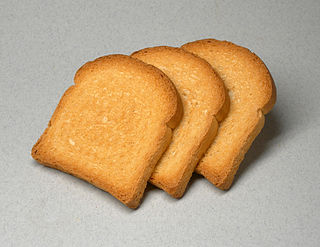
A rusk is a hard, dry biscuit or a twice-baked bread. It is sometimes used as a teether for babies. In some cultures, rusk is made of cake, rather than bread: this is sometimes referred to as cake rusk. In the UK, the name also refers to a wheat-based food additive.

Acheta domesticus, commonly called the house cricket, is a cricket most likely native to Southwestern Asia, but between 1950 and 2000 it became the standard feeder insect for the pet and research industries and spread worldwide. They can be kept as pets themselves, as this has been the case in China and Japan.

An animal product is any material derived from the body of an animal. Examples are fat, flesh, blood, milk, eggs, and lesser known products, such as isinglass and rennet.

Sake kasu (酒粕) or sake lees is a cooking ingredient that is white in color with a paste-like texture. The taste of sake kasu is fruity and has a similar taste to Japanese sake. Sake kasu is the lees left over from sake production. It is a by-product of Japanese sake production that contains 8% alcohol, has high nutritional value, and provides health benefits. Sake Kasu can be used as a marinade base in different Japanese dishes such as fish, vegetables, and meat, enhancing the umami flavor of the dish. Sake kasu can also be found in cosmetics and skincare products. Sake kasu is considered as a part of the Japanese “no waste” culture since the waste of the sake production is used in various ways. Mirin, a type of sweet Japanese sake can also produce kasu called mirin kasu. Similar to sake kasu, mirin kasu can also be used as a healthy food ingredient.

Tofu is a food prepared by coagulating soy milk and then pressing the resulting curds into solid white blocks of varying softness: silken, soft, firm, extra firm, or super firm. Tofu is also known as bean curd in English. Beyond these broad textural categories, there are many varieties of tofu. It has a subtle flavor, so it can be used in savory and sweet dishes. It is often seasoned or marinated to suit the dish and its flavors, and due to its spongy texture, it absorbs flavors well. It is a traditional component of East Asian and Southeast Asian cuisines, and has been consumed in China for over 2,000 years. In modern Western cooking, it is most often treated as a meat substitute.

A great variety of cassava-based dishes are consumed in the regions where cassava is cultivated, and the ingredient is included many national or ethnic specialities.
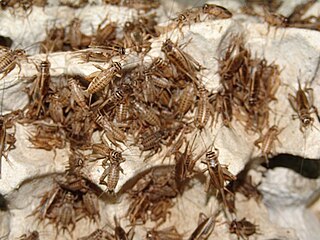
Insect farming is the practice of raising and breeding insects as livestock, also referred to as minilivestock or micro stock. Insects may be farmed for the commodities they produce, or for them themselves; to be used as food, as feed, as a dye, and otherwise.

Insects as food or edible insects are insect species used for human consumption. Over 2 billion people are estimated to eat insects on a daily basis. Globally, more than 2,000 insect species are considered edible, though far fewer are discussed for industrialized mass production and regionally authorized for use in food. Many insects are highly nutritious, though nutritional content depends on species and other factors such as diet and age. Insects offer a wide variety of flavors and are commonly consumed whole or pulverized for use in dishes and processed food products such as burger patties, pasta, or snacks. Like other foods, there can be risks associated with consuming insects, such as allergic reactions. As commercial interest in insects as food grows, countries are introducing new regulatory frameworks to oversee their production, processing, marketing, and consumption.
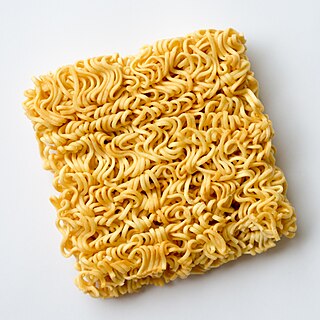
Instant noodles, or instant ramen, is a type of food consisting of noodles sold in a precooked and dried block with flavoring powder and/or seasoning oil. The dried noodle block was originally created by flash-frying cooked noodles, and this is still the main method used in Asian countries; air-dried noodle blocks are favored in Western countries. Dried noodle blocks are designed to be cooked or soaked in boiling water before eating. Ramen, a Japanese adaptation of Chinese noodle soup, is sometimes used as a descriptor for instant noodle flavors by some Japanese manufacturers. It has become synonymous in the United States with all instant noodle products.

Hemp juice is a beverage derived from industrial hemp, made from the result of pressing the Cannabis sativa plant. The juice is obtained through a large-scale industrial cold-pressing procedure using the upper parts of the hemp plant as well as the leaves. This procedure distinguishes hemp juice from other hemp products such as hemp oil, hemp sprouts or hemp milk, which are obtained through the seeds of the hemp plant.
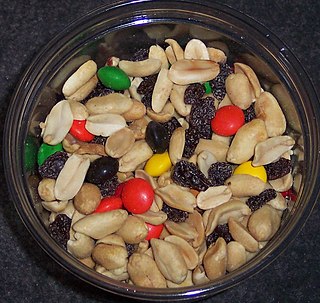
A snack is a small portion of food generally eaten between meals. Snacks come in a variety of forms including packaged snack foods and other processed foods, as well as items made from fresh ingredients at home.
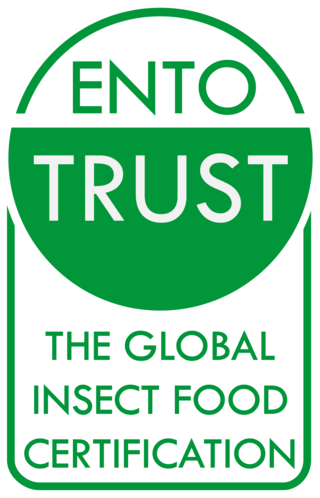
The Entotrust certification is a voluntary product certification of insects as food, and related insect-based foods, which allows producers to communicate their food safety and sustainability. Increasingly used, in Europe, Africa, Asia, USA, Mexico, and Latam with the mission to recognize and report quality products based on edible insects, the logo can only be used by fully certified producers and farmers.




















